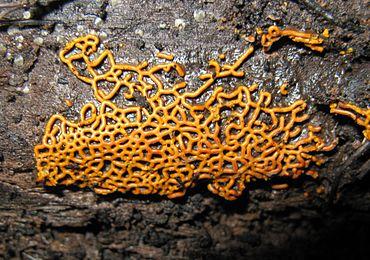
A plasmodium is a living structure of cytoplasm that contains many nuclei, rather than being divided into individual cells each with a single nucleus.
Plasmodia are best known from slime molds, but are also found in parasitic Myxosporea, and some algae such as the Chlorarachniophyta.
Structure
A plasmodium is an amoeboid, multinucleate, and naked mass of cytoplasm that contains many diploid nuclei. The resulting structure, a coenocyte, is created by many nuclear divisions without the process of cytokinesis, which in other organisms pulls newly-divided cells apart.[1] In some cases, the resulting structure is a syncytium, created by the fusion of cells after division. Under suitable conditions, plasmodia differentiates and forms fruiting bodies bearing spores at their tips.
Taxonomic distribution
The term plasmodium, introduced by Leon Cienkowski,[2] usually refers to the feeding stage of slime molds; these are macroscopic mycetozoans.[3]
The multinucleate developmental stages of some intracellular parasites, namely Microsporidia (now in Fungi) and Myxosporidia (now in Cnidaria), former cnidosporans, are also sometimes called plasmodia.[4]
Similarly, in Rhizaria, the amoeboid, multinucleate protoplasts of some Cercozoan algae, e.g. Chlorarachniophyta, are called plasmodia. These lack cell walls; the syncytia are created by cell fusion. Some plasmodiophorids and haplosporidians are other multinucleated rhizarians.[5]
References
- ^ Sharma OP. (1988). "4. Myxomycota". Textbook of Fungi. Boston: McGraw Hill Higher Education. pp. 33–48. ISBN 978-0-07-460329-1. Retrieved January 31, 2013.
- ^ Kuznicki, L. & Dryl, S. (1987). Leon Cienkowski. Acta Protozoologica 26 (1): 1-2, [1].
- ^ Berg, Linda (2008). Introductory Botany: Plants, People, and the Environment (2nd ed.). Belmont CA: Thomson Corporation. p. 398. ISBN 978-0-03-075453-1.
- ^ Hoek, C. van den, Mann, D.G. and Jahns, H.M. (1995). Algae An Introduction to Phycology. Cambridge University Press, Cambridge. ISBN 0-521-30419-9.
- ^ Brown MW, Kolisko M, Silberman JD, Roger AJ. (2012). Aggregative Multicellularity Evolved Independently in the Eukaryotic Supergroup Rhizaria. Current Biology, Volume 22, Issue 12, 1123-1127.